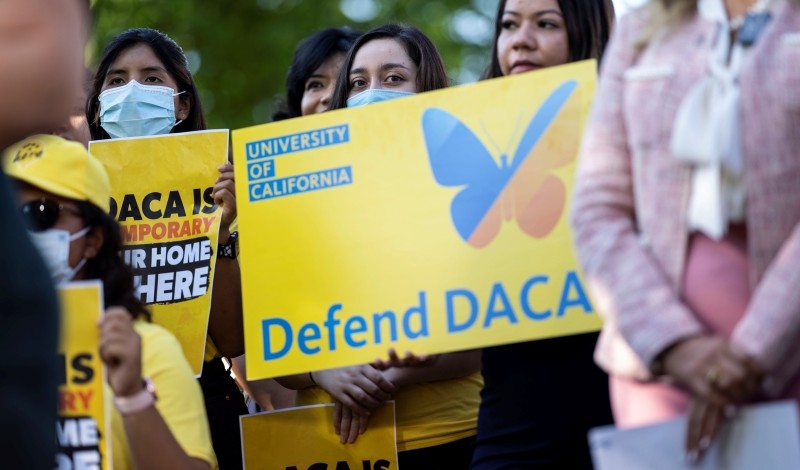
Scholars unveil new research on the challenges undocumented students face in the wake of DACA’s retrenchment.
The re-election of President Donald J. Trump puts the future status of undocumented people in jeopardy. For college-aged undocumented individuals, however, new research shows that circumstances have already been precarious for several years.
In a forthcoming article, William C. Kidder, a research associate for the Civil Rights Project of the University of California, Los Angeles, and Kevin R. Johnson, Dean and Distinguished Professor of Law at the University of California, Davis School of Law, examine how the decline of the Deferred Action for Childhood Arrivals (DACA) program has impacted undocumented college students in the University of California (UC) and California State University (CSU) systems. They conclude that policy changes in the past decade have created significant challenges for undocumented students, resulting in a sharp decline in college enrollment for low-income undocumented individuals. Given this trend, Kidder and Johnson emphasize the urgent need for policy interventions to mitigate the negative consequences of DACA’s retrenchment.
Introduced by the Obama administration in 2012, DACA grants work authorization and temporary relief from deportation to eligible undocumented individuals who arrived in the United States as children. This program allows recipients—often referred to as “Dreamers”—to pursue higher education and employment opportunities. In addition to federal protections, DACA recipients in states such as California may gain access to in-state tuition, financial aid, and certain professional licenses, improving their ability to attend and complete college.
The Trump Administration’s attempt to rescind DACA in 2017 marked a turning point, triggering a series of legal battles and administrative restrictions that curtailed the program’s reach. By 2022, nearly all undocumented high school graduates were ineligible for DACA due to its 2007 residency cutoff, leaving a new generation of students without access to its benefits. These restrictions have created widespread uncertainty and anxiety for undocumented individuals and their families.
According to Kidder and Johnson, these restrictions have also limited undocumented students’ opportunities to succeed in higher education. Analyzing enrollment trends among undocumented students at UC and CSU campuses from 2016 to 2023, they found that the number of newly enrolled undocumented students who received California Dream Act financial aid dropped by more than 50 percent at UC campuses, from 1,181 students to 579. CSU campuses experienced a similar decline, with new Dream Act recipients decreasing more than 48 percent over the same period.
For continuing students, the decline was more gradual but still substantial. Between 2018 and 2023, the overall number of low-income undocumented students receiving aid at UC and CSU campuses decreased by approximately 30 percent. According to Kidder and Johnson, this trend reflects the delayed effects of DACA’s rollback, as earlier cohorts of DACA-eligible students graduated and fewer new students enrolled to replace them. Notably, these declines were not mirrored among other low-income student groups at UC and CSU. Kidder and Johnson attribute this difference to the diminishing accessibility of DACA.
Kidder and Johnson also emphasize that the loss of DACA eligibility is just one of many challenges faced by undocumented students. Without work authorization, undocumented students cannot legally obtain most on-campus or off-campus jobs, forcing them to rely more heavily on financial aid, scholarships, and family support. Federal financial aid programs such as Pell Grants and Work-Study, however, exclude undocumented students from eligibility, leaving them dependent on state programs such as the California Dream Act, which do not fully cover their financial needs.
Kidder and Johnson note that financial insecurity often leads to other hardships, such as housing instability, food insecurity, and long commutes, which can undermine academic success and well-being. The emotional toll of living with uncertain legal status further exacerbates these burdens, as undocumented students must navigate a system that often feels unwelcoming and exclusionary.
Despite these challenges, Kidder and Johnson identify several promising strategies to improve outcomes for undocumented students, even without federal immigration reform. One approach involves leveraging legal arguments to challenge employment restrictions for undocumented students. The Opportunity for All campaign, for example, proposes that public universities can lawfully employ undocumented students under certain circumstances, a position supported by recent legal analyses. Expanding employment opportunities, Kidder and Johnson maintain, would enhance the financial stability and educational attainment of undocumented students.
Kidder and Johnson also recommend fostering partnerships between universities, private philanthropies, and advocacy organizations to provide scholarships and other financial assistance for undocumented students. For example, they show that some universities have introduced voluntary student fees that unlock matching private funds to support undocumented students, an innovative model that Kidder and Johnson argue could be replicated elsewhere.
In addition, Kidder and Johnson advocate the expansion of existing campus-based support services. Many UC campuses have established undocumented student resource centers that provide academic advising, mental health counseling, and legal services. For example, the University of California Immigrant Legal Services Center, based at UC Davis School of Law, offers free immigration legal services to students and their families. Kidder and Johnson underscore the importance of these programs, as they address immediate needs while fostering a sense of belonging and empowerment among undocumented students.



